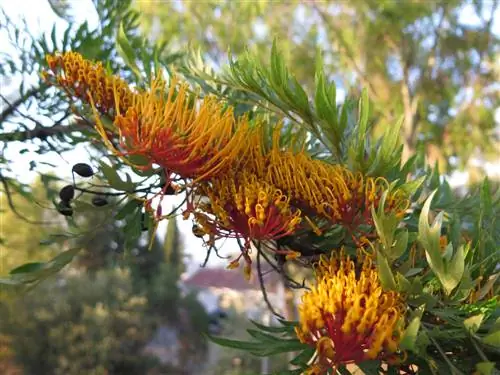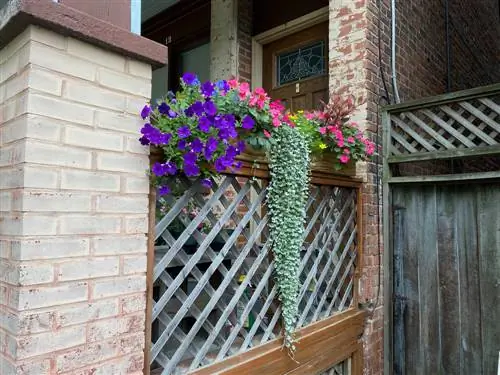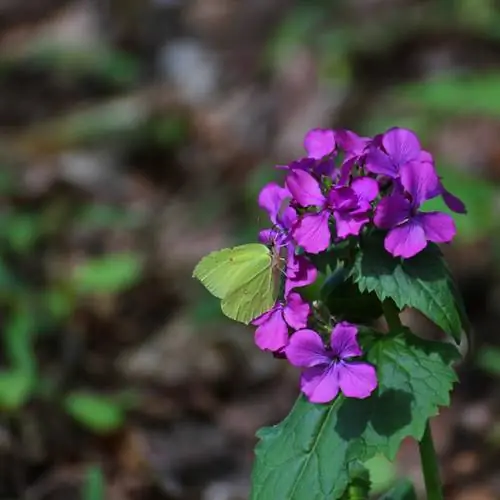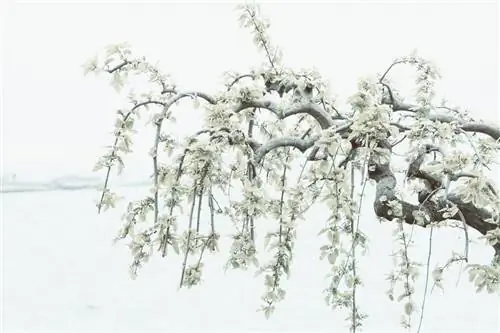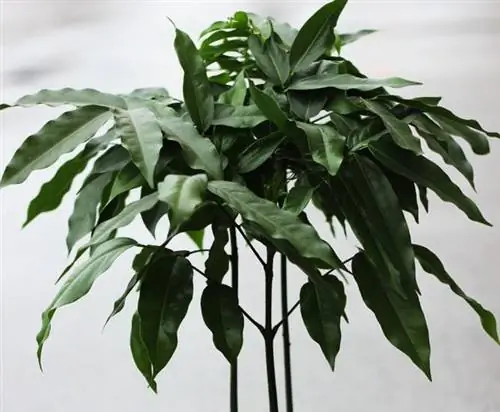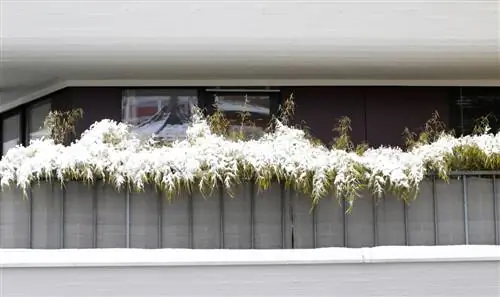- Author admin [email protected].
- Public 2023-12-16 16:46.
- Last modified 2025-01-23 11:22.
Read a commented silver oak profile here with explanations of growth, leaves and flowers. Tried-and-tested tips explain how to properly cultivate Australian Grevillea as a container plant.
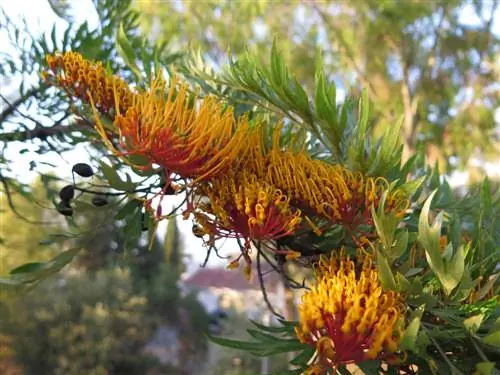
What are the most important care instructions for a silver oak tree?
The silver oak (Grevillea robusta) is a fast-growing, evergreen plant from Australia that is valued for its fern-like, shimmering silver leaves and bizarre claw-shaped flowers. Cultivated as a container plant, it prefers sunny locations, moderate watering and phosphate-free fertilizing. Overwintering at 10°C to 15°C promotes flower formation.
Profile
- Scientific name: Grevillea robusta
- Family: Silver Tree Family (Proteaceae)
- Synonyms: Grevillee, Australian silver oak
- Origin: Australia
- Growth type: evergreen tree, shrub
- Growth height: 3 m to 5 m
- Leaf: bipinnate
- Flower: bizarre claw-shaped
- Fruit: Skin Fruit
- Toxicity: slightly toxic
- Winter hardiness: sensitive to frost
- Use: potted plant
Growth
The silver oak (Grevillea robusta) is a fast-growing tree or shrub from the silver tree family (Proteaceae). Based on its rainy habitats in eastern Australia, the evergreen deciduous tree is also called Australian silver oak and grevillea. The German name silver oak is an allusion to decorative, fern-like leaflets with a silvery shimmer. Spectacularly shaped flowers intensify the extravagant appearance of adult silver oaks. These key growth data explain why Grevillea robusta is so highly valued in this country as a beautiful pot plant all year round:
- Growth type: Tree or shrub with evergreen pinnate leaves, claw-like inflorescences and dark brown follicles.
- Growth habit: upright, slender-columnar, loosely branched.
- Growth height in habitat: 20 m to 35 m
- Growth height as a container plant: 3 m to 5 m
- Roots: Shallow roots with a high proportion of proteoid roots (dense tufts of tender roots to improve nutrient uptake in the poor Australian soil).
- Gardenically interesting properties: easy to care for, sensitive to frost, tolerates cutting, sun-loving, slightly toxic, fast growing.
Video: Australian silver oaks in a natural location
Leaf
A silver oak has a beautiful foliage of filigree leaves all year round with these characteristics:
- Leaf shape: petiolate, bipinnate.
- Leaf size: 20 cm to 30 cm long.
- Leaf color: evergreen, deep green to bronze on top, light green on the bottom, silver-grey hairy.
Silver oak leaves contain tridecylresorcinol. This toxin can cause allergic reactions if it comes into direct contact with the skin under sunlight.
Bloom
Cultivated as a container plant, a grevillea keeps its bizarre flowers under wraps for the first few years. This is not contradicted by the fact that an adult silver oak surprises with these flowers in the light-filled winter garden:
- Inflorescence: racemose, 8 cm to 15 cm long, composed of numerous tubular flowers.
- Special feature: widely protruding stamens create a claw-shaped appearance.
- Flower color: golden yellow to orange-yellow.
- Flowering time: January to April.
- flower ecology: hermaphrodite
Pollinated flowers turn into leathery, dark brown follicles containing one or two seeds. Flowers, fruits and seeds contain toxic cyanide compounds. Consuming large quantities can cause nausea and vomiting.
Planting silver oaks
Ready-to-plant silver oak can be purchased from local specialist retailers and online shops. Prices range between 24.95 euros for a 30 cm small specimen and 249.90 euros for a 3 m tall Grevillee tree. Indoor gardeners favor container planting following vegetative or generative propagation. The requirements for the optimal location must also be met north of the Alps. You can read how to successfully propagate and skillfully plant a silver oak tree here:
Propagation by cuttings
Grevillee cuttings root faster as cracklings. The following instructions explain step by step how to do it correctly:
- Carefully tear or cut off a two-year-old branch from the trunk along with a tongue of bark.
- Fill the pot with coconut soil or lime-free potting soil over expanded clay drainage.
- Defoliate the cutting except for the upper pair of leaves.
- Drill a planting hole with a pricking stick and plant two thirds of the cutting.
- Moisten the substrate with soft water, spray the cutting.
The silver oak cutting is cultivated in the bright window seat in the warm, humid microclimate under a transparent hood. Young leaves sprout as an indication of successful rooting.
Extra tip: If there is a thin layer of leaf compost between the potting soil and the drainage, timid silver oak cuttings will make more effort to develop roots in order to access the tempting nutrient buffet.
Propagation by sowing
Sowing silver oak seeds is a time-consuming project. It takes up to 12 months before the first Grevillee seedlings appear. The following table provides information about all important framework conditions:
| Sowing | Framework data |
|---|---|
| Time slot | all year round, ideally in spring |
| Preparation | Soak seeds for 24 hours |
| Seed container | Pot, propagation box |
| Seed substrate | Coconut soil |
| Sowing depth | 0-0.5 cm (light germinator) |
| germ temperature | 20° to 25° Celsius |
| Germination time | 1 to 12 months |
| Continuing cultivation of seedlings | bright, 18° to 20° Celsius |
| Sowing care | keep moist, no waterlogging |
Silver oak seedlings with two leaves are fertilized every two weeks with a phosphate-free liquid fertilizer at half the concentration.
Planting Tips
Commercial potting soil is not suitable for Grevillea robusta. In keeping with the lean, slightly acidic soil of Australia, a mixture of rhododendron soil without peat, coconut soil as a peat substitute, lava granules and sand is recommended as a substrate. Further planting tips get to the heart of important details:
- The still potted root ball is placed in a bucket of rainwater before planting.
- A 5 cm high expanded clay drainage on the bottom of the bucket prevents waterlogging.
- If the coaster is covered with expanded clay balls, accumulated water can evaporate and increase the local humidity.
- The previous planting depth is retained and takes a watering edge into account.
- Pervasive watering on the day of planting and afterwards promotes rapid rooting in the pot substrate.
Location
The ideal location for a silver oak as a container plant simulates the conditions of the Australian coastal regions between Queensland in the southeast to New South Wales in the northeast with up to 1000 millimeters of rainfall per year:
- Sunny to shady location without hours of blazing midday sun.
- Temperature minimum: 10° Celsius
- High humidity of at least 50 percent.
- Ideal conditions in summer for rapid growth: very bright, humid, 18° to 25° Celsius.
- Ideal winter conditions for flower formation: sunny, humid, 10° to 15° Celsius.
From April to October, the Australian silver oak prefers to stay on the sunny balcony.
Excursus
Silver oaks in mini format
The juniper-leaved silver oak (Grevillea juniperina) comes as a pot plant for small balconies and winter gardens. The Australian silver tree plant remains at a height of 80 cm to 100 cm. At first glance, its needle-shaped leaves are reminiscent of a conifer. The red claw flowers contain sweet nectar that you can suck.
Care for silver oaks
The Australian silver oak is easy to care for. Moderate watering, phosphate-free fertilization and cool wintering are the mainstays of the simple care program. Gloves and long-sleeved clothing protect against phototoxic skin irritation. This is how a silver oak is properly cultivated as a container plant:
Pouring
- Keep the substrate constantly slightly moist from spring to autumn.
- Let the surface of the soil dry to the touch between waterings.
- From 18° Celsius, spray the leaves with decalcified water in the morning or evening.
- Watere more sparingly in winter without letting the substrate dry out.
- Water silver oaks predominantly with decalcified tap water or filtered rainwater.
Fertilize
- Australian silver tree plants are fertilized with a phosphate-free liquid fertilizer (e.g. protein fertilizer (€11.00 on Amazon) from Flora Toskana).
- From March to September, stir 2 grams of fertilizer powder into 1 liter of irrigation water every 10 days.
- Water silver oaks thoroughly with the liquid fertilizer to supply the roots with nutrients right down to the bottom of the pot.
Cutting
- Cut back Grevillee if necessary.
- Best time is in March/April.
- The robust pruning tolerance allows pruning by up to two thirds.
- Place scissors just above an outward-facing leaf, bud or eye.
Wintering
The wintering of a silver oak has been discussed several times. Read a compact summary here. How to overwinter Grevillea robusta correctly:
- Put away potted plants when temperatures fall below 12° Celsius.
- Ideally overwinter sunny to very bright and cool at 10° to 15° Celsius.
- Recommended winter quarters: winter garden, glazed terrace, bright staircase, unheated bedroom.
- Optionally winter in heated living rooms under a daylight lamp as additional lighting.
- Winter care: water sparingly, do not let it dry out, avoid waterlogging, do not fertilize, spray regularly.
Repotting
The fast-growing silver oak is repotted every one to two years. The best time is in spring. The current bucket can be reused as long as two fingers fit between the root ball and the edge of the container. After repotting, a grevillea should only be fertilized for the first time after six weeks at the earliest.
Diseases and pests
The silver oak is usually spared from infestation by diseases and pests. It is primarily care errors that cause headaches. Incorrect water supply, which leads to drought stress or waterlogging, is particularly problematic. The nutrient supply with a conventional, phosphate-containing fertilizer causes the lush green leaves to yellow.
Popular varieties
These multi-faceted varieties compete with Grevillea robusta for the title of the most beautiful Australian silver oak:
- Robyn Gordon: compact Australian silver tree as a small shrub with red flowers from spring to autumn, height up to 150 cm.
- Bank's Australian Silver Oaks: Small tree or shrub impresses as a permanent bloomer with fire-red tubular flowers on 10 cm long inflorescences, growth height up to 300 cm.
- Johnson's Silver Oaks: Grevillea johnsonii scores with deeply cut pinnate leaves and red-orange claw-colored flowers from April, growth height up to 150 cm.
- Flaming Australian silver oaks: Grevillea rhyolitica grows waist-high, bears needle-shaped leaves and pink-red flowers on elegantly overhanging branches, height 80 cm to 100 cm.
FAQ
Why should silver oak be fertilized without phosphates?
Silver trees have adapted well to the lean, low-phosphate soil of Australia with special roots. Conventional fertilizer causes an excess of phosphate. The absorption of other nutrients is inhibited or completely stopped, with negative consequences for overall growth. For this reason, silver oak is fertilized phosphate-free with a special fertilizer, such as Protea liquid fertilizer from Green24, proteen fertilizer from Flora Toskana or Engelhardt's garden fertilizer phosphate-free.
Is Grevillea robusta the only Australian silver oak?
Grevillea robusta is the best-known plant species within the extensive genus of silver oak (Grevillea). Other beautiful Grevillee species are cultivated in this country as potted plants under the name Australian Silver Oaks. These include Johnson's silver oak (Grevillea johnsonii), juniper-leaved silver oak (Grevillea juniperina) and the everflowering Australian silver oak (Grevillea semperflorens).
Is a silver oak poisonous?
The silver oak (Grevillea) is declared as slightly poisonous for reasons of caution. The parts of the plant contain various substances that are harmful to he alth and can trigger allergic reactions and symptoms of poisoning. However, actual poisonings have not yet been reported in the literature.

